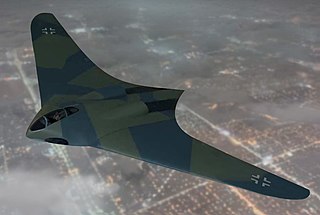
The Horten H.IX, RLM designation Ho 229 was a German prototype fighter/bomber designed by Reimar and Walter Horten to be built by Gothaer Waggonfabrik. Developed at a late stage of the Second World War, it was one of the first flying wing aircraft to be powered by jet engines.

The Henschel Hs 132 was a World War II dive bomber and interceptor aircraft of the German Luftwaffe that never saw service. The unorthodox design featured a top-mounted BMW 003 jet engine and the pilot in a prone position. The Soviet Army occupied the factory just as the Hs 132 V1 was nearing flight testing, the V2 and V3 being 80% and 75% completed.

The DFS 230 was a German transport glider operated by the Luftwaffe in World War II. It was developed in 1933 by the Deutsche Forschungsanstalt für Segelflug with Hans Jacobs as the head designer. The glider was the German inspiration for the British Hotspur glider and was intended for airborne assault operations.

The Messerschmitt Me 321 Gigant was a large German cargo glider developed and used during World War II. Intended to support large-scale invasions, the Me 321 had very limited use due to the low availability of suitable tug aircraft, high vulnerability whilst in flight, and its difficult ground handling, both at base and at destination landing sites. The Me 321 was developed, in stages, into the six-engined Messerschmitt Me 323 Gigant, which removed some of the problems with ground handling, although the payload was reduced. Vulnerability to ground fire and aerial attack remained a constant problem during operations of all variants.
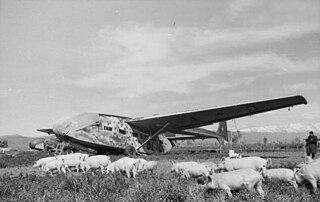
The Gotha Go 242 was a transport glider used by the Luftwaffe during World War II. It was an upgrade over the DFS 230 in both cargo/troop capacity and flight characteristics. It saw limited combat action. There were multiple glider variants, and it became the basis for a transport aircraft, the: Gotha Go 244.
The Gotha Go 244 was a transport aircraft used by the Luftwaffe during World War II.

The Gribovsky G-11 was a Soviet light troop/cargo military glider of World War II.

The Antonov A-7 was a Soviet light troop military glider of World War II.

The Gotha Ka 430 was a military transport glider, first built in 1944. The glider was designed by Albert Kalkert. Twelve had been produced by the end of World War II, but none of them was used operationally.
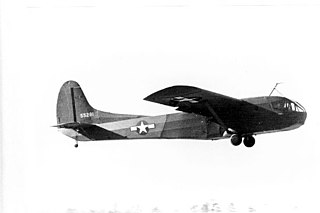
The Waco CG-15 was an American military glider, which was developed from the CG-4. Although outwardly similar to its predecessor and carrying the same number of passengers, a number of changes in the design, including shortened wings and a more streamlined nose enabled it to travel faster. 1,000 were ordered and 473 were delivered before production ceased. Two were transferred to the Navy for testing as the XLR2W-1. One unit was converted into an XPG-3 powered glider which used two Jacobs R-755-9 radial engines.

The Kokusai Ku-7 Manazuru was a large experimental twin boom Japanese military glider.

After the success of the 1940 airborne assaults involving the DFS 230, the Reichsluftfahrtministerium invited the Deutsche Forschungsanstalt für Segelflug/DFS and Gotha to submit plans for a larger capacity glider. The result was the DFS 231, a twenty-seat troop designed by Hans Jacobs, who had previously produced the successful, nine seat DFS 230.

The Gotha Go 145 is a German World War II-era biplane of wood and fabric construction used by Luftwaffe training units. Although obsolete by the start of World War II, the Go 145 remained in operational service until the end of the War in Europe as a night harassment bomber.

The Waco CG-13 was an American military transport glider aircraft developed during World War II.
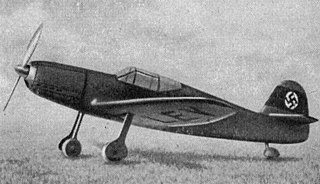
The Gotha Go 149 was a military aircraft developed in Germany in the mid-1930s for training fighter pilots. It was a conventional low-wing cantilever monoplane with tailwheel undercarriage, the main units of which retracted inwards. The wing was wooden, while the monocoque fuselage was metal. Two prototypes were constructed, and an armed version was also proposed as a light home-defence fighter (Heimatschutzjäger) armed with two 7.92 mm (.312 in) MG 17 machine guns, but the Luftwaffe did not purchase either version of the design, and no further examples were built.

The Gotha Go 147 was a German experimental two-seat tailless aircraft designed in 1936 by Gothaer Waggonfabrik and Dr. A. Kupper. Two examples were built and flown. Development was abandoned before the start of World War II.

The Gotha Go 150 was a light aircraft designed at the German company Gothaer Waggonfabrik in the late 1930s. It was intended for civilian use, but ended up being used as a military trainer.
The DFS 230F was a military assault glider designed and built in Germany, by Gotha during World War II, to succeed the smaller DFS 230 which it was only related to by name.
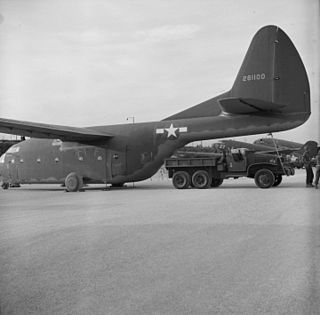
The Laister-Kauffman CG-10 was an American military transport glider aircraft developed during World War II.
The Douglas CG-19 was a late 1940s assault glider project conceived by the Douglas Aircraft Company.

















